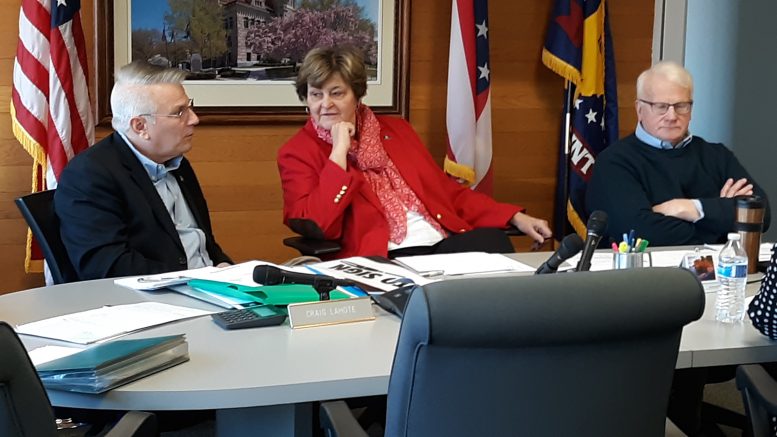By JAN LARSON McLAUGHLIN
BG Independent News
When the pandemic struck in March, Wood County government prepared for the worst. Revenue from sales tax, gas tax, casino tax and interest took a nosedive initially.
“When all this started, we anticipated we would have reduced revenue,” Wood County Administrator Andrew Kalmar said.
But as the pandemic dragged on, a rebound occurred in some of those pots of revenue. Sales tax more than recovered, property taxes held steady, and the casino tax for the third quarter of the year was the highest ever.
But next year still holds some uncertainties, so when Wood County commissioners Doris Herringshaw, Craig LaHote and Ted Bowlus adopted the budget for 2021 this morning, they didn’t take any chances.
“Only time will tell how the pandemic will affect our financial condition throughout 2021 and beyond,” the commissioner wrote in their budget letter this morning.
The appropriations for 2021 total $45.5 million, which is about $27,000 more than for 2020.
The county’s approximately 1,000 employees were granted 2.5% raises for the coming year. Last year, they were given 3% raises.
“We’re in good financial condition – we just want to stay that way,” Kalmar said. “We just don’t know what will happen.”
Some capital projects put on hold this year will remain in a holding pattern for now. But some projects may move forward next year if conditions allow.
The biggest of those is the expansion of the Wood County jail. The commissioners will discuss that project – expansion of both the inmate housing, and the booking and medical areas – in January, Kalmar said.
Moving of the highway garage from East Poe Road to the county’s East Gypsy Lane Road complex will also be discussed next year.
“We’ll see if we can get that put back on track as well,” Kalmar said.
Due to COVID, planned renovations in Courtrooms 1 and 2 in the county courthouse were put on hold this year.
“Those will occur in 2021,” Kalmar said.
And more office space is planned to be added to the adult probation office, since the addition of another probation officer was approved.
It is also expected that next year the commissioners will work with Wood County Sheriff Mark Wasylyshyn on funding to replace body cameras and dashcams. That is projected to cost about $350,000, which will be paid over five years in annual increments of $70,000.
Most requests for new employees were not approved by the county commissioners, who were being cautious after this difficult year, Kalmar said.
“New staff are a continuing expense. So we didn’t feel it was a time to make promises of new employees,” he said.
The commissioners are considering one request from the courts for an additional information technology person, who might also serve other county offices.
“The pandemic stretched the limits of our IT staff,” Kalmar said. They helped departments learn to work remotely from home, and to host virtual meetings.
“The IT staff started running in March, and I don’t think they’ve stopped,” he said.
As for revenue coming into the county in 2020, the commissioners were pleasantly surprised. It was projected that sales tax would plummet – but Wood County ended up bringing in $1.6 million more than last year.
Kalmar said the increase was likely due to people not being able to travel, so they stayed home and invested in home improvements, and bought items online. The county benefited from the recent legislation that allows county sales tax to be collected on sales made online.
Property tax collections remained steady, and gas tax leveled off after an initial drop.
Interest income did not recover. The county was collecting more than $2 million a year in interest, but that dropped down to between $800,000 and $900,000. That is a significant difference from 2007, when the county made $2.6 million in interest income.
As for casino tax revenue, the county normally gets about $1.2 million a year. The payment for the first quarter of 2020 was $425,000. That plummeted to $28,000 in the second quarter, then rebounded to $444,000 in the third quarter of 2020.
“That’s the most we’ve ever received,” Kalmar said.

